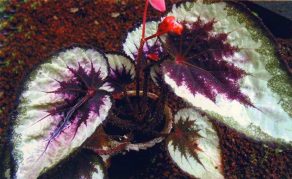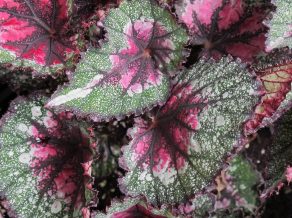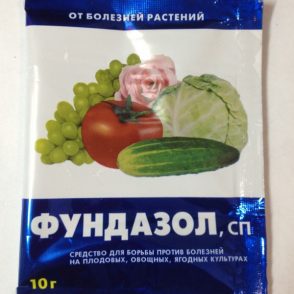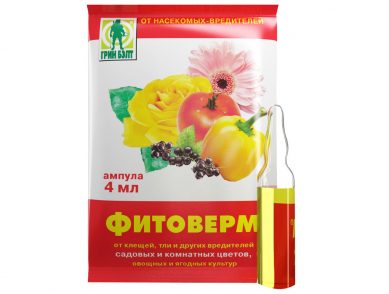Royal begonia, or as it is also called, begonia rex, attracts attention with brightly colored leaves. They, like huge butterflies with variegated wings, adorn the plant all year round. Various varieties of begonias differ in the size of the bushes and color.
Material Content:
Royal begonia: description and nuances of growing
This is a herbaceous plant with a fleshy, hairy, shortened stem, to which leaves are attached on long petioles. Large leaf plates with a pointed apex are asymmetrical, they have serrated edges. The upper part of the sheet has a velvety surface with a bright pattern, the lower part is dark green with a reddish tint. Flowers inconspicuous, small, pink. The highest height of the bush is up to half a meter.

Popular varieties:
- Dolar Daon. The bush is miniature, scarlet leaves with a black border around the edge.
- Snail. Instances grow no more than 30 cm in height. The corrugated sheet plate, twisted into a spiral at the petiole, is painted in olive color with silver stripes.
- Griffin. Medium height with large leaves plant. In the color there are green and bright pink colors.
The plant needs special care. It is more demanding than other varieties of begonias to air humidity. Ignorance of the nuances of growing can lead to loss of decorative leaves and death of the specimen.
When to transplant a flower after purchase
Begonia loves light nutrient soil and wide, shallow pots. But immediately replanting the plant after purchase is undesirable.It should adapt to the new conditions of existence for about a week.
Royal Begonia Care at Home
Royal begonia is unpretentious in care, it reproduces easily and does not drop leaves in winter. The plant loves moist, warm air and bright, diffused light. Knowing the characteristics of growing a plant will help maintain its beauty for a long time.
Home care can cause difficulties only in the heating winter period, since the plant needs air with a humidity of at least 60%. To solve this problem, you can put a pot in the kitchen, where the air is always more humid.
How often should I water the plant
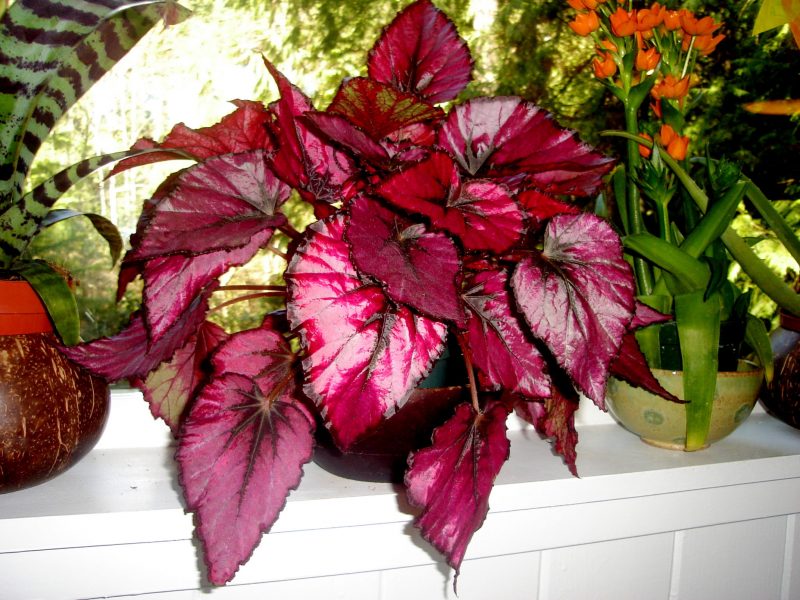
- Begonia is watered regularly, and the frequency of watering depends on the dryness of the air in the apartment.
- The soil in the flower pot should dry 1 cm deep before the next watering.
- It is advisable to avoid dropping water on the leaves.
Do not leave water in the pan of the flower pot. After watering, you need to immediately clean it. Begonia does not like stagnation of water at the roots.
Water for irrigation should be soft. You can drop a small cloth bag with peat in a two-liter container with tap water overnight, and its quality will improve significantly. Water passed through a food filter is also well suited for watering flowers.
Optimal conditions
Royal begonias need diffused bright light. In order to avoid loss of motley coloring of leaves, it is impossible to place it in a dense shadow.
The optimum growing temperature is from +16 to + 22 ° C. In winter, the plant is protected from drafts and dry air from heating batteries.
Dust collects on broad, large leaves of begonia. Wipe it with a semi-moist sponge. The plant does not like spraying. If the air in the apartment is very dry in winter, water is sprayed around the flower from the spray gun or wet claydite and sphagnum are placed next to it.
Fertilizer application
The plant needs frequent top dressing, approximately 1 time in 10 days. The plant needs fertilizer during active growth, but the royal begonia grows year-round, so they do not stop fertilizing it even in winter.
It is interesting: tuber begonia: planting and care in the garden
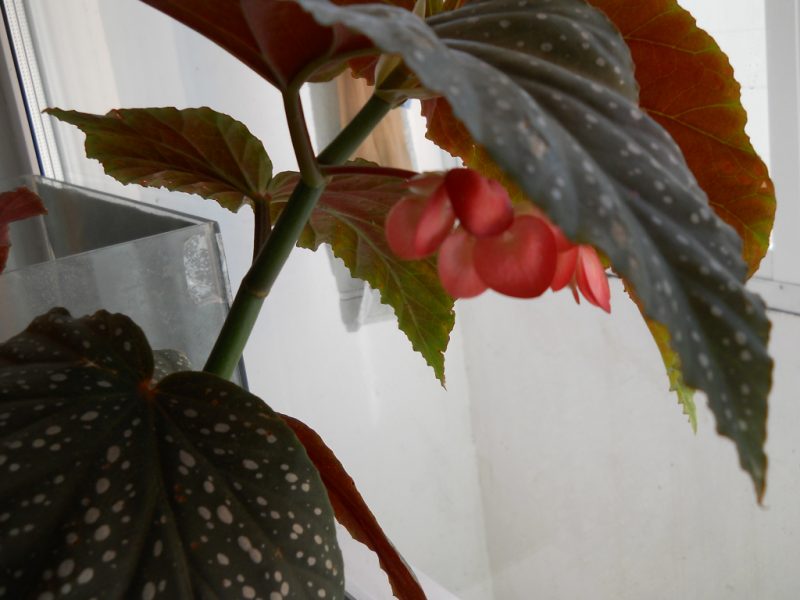
Complex fertilizers are used for indoor decorative and deciduous crops, with the same ratio of the main nutrient components - nitrogen, phosphorus and potassium. In the winter, preference is given to preparations with a predominance of phosphorus.
Transfer
Begonia can be transplanted annually. To do this, choose a pot of slightly larger diameter than the one in which it grows. The best time for transplantation is March, when the plant wakes up from winter sleep and is full of strength for new growth.
How to care for a royal begonia in a dormant period
Royal begonia does not have a pronounced dormant period. It does not shed its leaves in winter, but its growth in the winter is slightly suspended in the same way as other evergreens indoor plants.
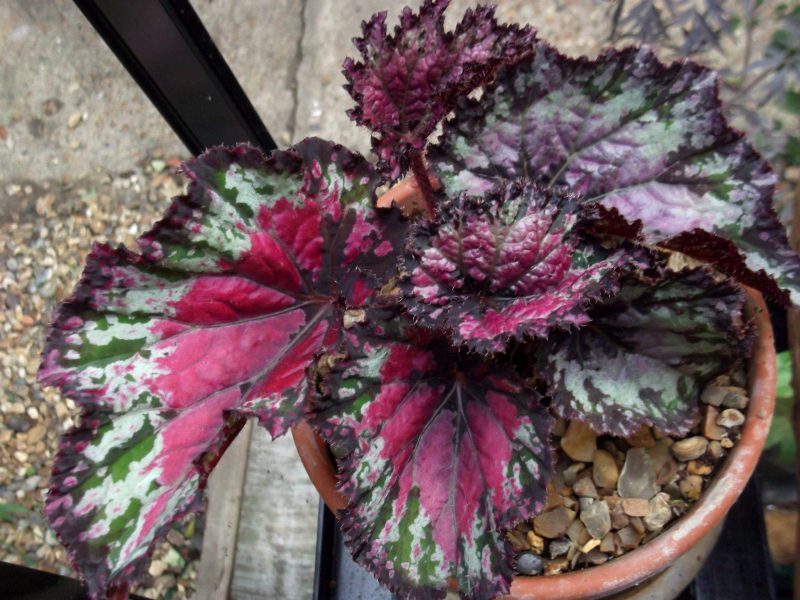
Caring for begonias in winter is to reduce the amount of watering and maintain optimal air humidity. In late February, you can propagate the plant.
Begonia breeding
Most often, the royal variety is propagated by leaves. From one bush can get up to 20 new plants.
For reproduction, well-formed leaves with noticeable veins on the back side are chosen.
- In a pot filled with moist, light soil, lay a begonia leaf horizontally and crush it with pebbles. Before this, the stalk is cut and cuts are made with a sharp blade on the veins on the back of the sheet. The cuts should be located closer to the base where the stalk used to grow.
- The pot with a leaf is covered with a transparent film and put in a bright, warm place.
- After a few days, the pebbles from begonia can be removed.
- After about 2 or 3 weeks, tiny sprouts will appear at the site of the incisions from the leaf. When their leaves are the size of a 10-kopek coin, the remains of an unrooted leaf plate are cut with scissors, and the grown seedlings are transplanted into separate pots.
Begonia is also propagated by dividing the rhizome during spring transplantation.
Diseases and Pests
Most often, begonias suffer from fungal diseases that cause too frequent and heavy watering.
If the leaves become covered with spots and plaque, then the affected areas are cut off and treated with fungicide.
Pay attention to some begonias and their treatment methods:
- Gray rot. It appears in the form of watery gray spots on the leaves and stalk, they rot. The leaves turn black and fall, the plant dies. You can save it by treating it with a solution of copper sulfate or Fundazol.
- Powdery Mildew Rounded white spots form a powdery coating on the leaves, plant tissues die. For treatment, a solution of colloidal sulfur, Fundazole or Morestan is used.
- Bacterial spotting. Vitreous spots appear on the back wall of the leaves, which then acquire a brown color. With a small lesion, diseased leaves are cut off, and the plant is treated with copper chloride every two weeks.
In addition to fungal and bacterial diseases, insect pests, such as scale insects, thrips, aphids, spider mites, and others, can settle on begonias. In indoor conditions, safe insecticides, for example, Fitoverm, are used to destroy them. If there are few insects, you can try folk methods of dealing with them - spray the leaves with a strong infusion of tobacco, garlic or a decoction of tomato tops.
Royal begonia flower fits perfectly into any interior, its leaves are striking in a variety of shapes and colors. The short life of the plant, about 3 years, is offset by the possibility of obtaining new seedlings from the leaves.


